Traditional architecture firm marketing efforts aren’t enough for today’s architects. Potential clients are now searching online, comparing portfolios, and expecting a seamless digital experience before they ever reach out.
That shift means your online visibility is just as important as your ability to design.
In this guide, you’ll discover actionable marketing strategies that modern architects and architectural firms are using to attract new clients, build trust, and win more of the projects they want.
Key Takeaways
- Build a strong digital foundation with a polished website and optimized Google Business profile.
- Use portfolio visuals, storytelling, and real project narratives to showcase your expertise.
- Blend SEO, content marketing, and social media marketing to increase your visibility and authority.
- Leverage Cedreo’s intuitive 3D design tools to quickly create stunning visuals and client-ready presentations that help close deals faster.
Why trust us? Here at Cedreo, we’ve got 20+ years of experience working with professionals in the home design space. We know what it takes for architecture firms to create an effective marketing strategy to land more clients!
See How You Can Create Complete Projects with Cedreo
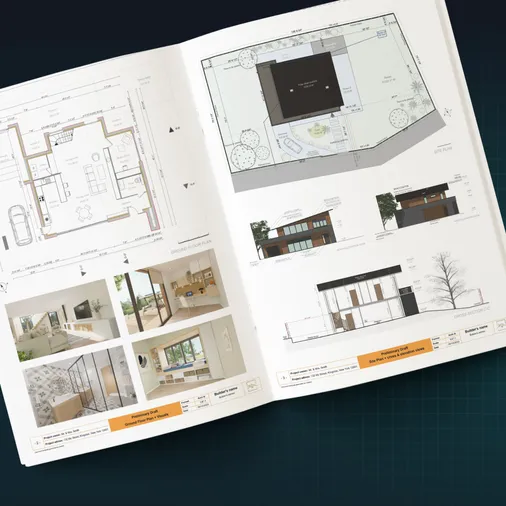
Plans – Get site plans, 2D floor plans, electrical plans, cross sections and elevation views — with all the technical details you need for a comprehensive project overview.
3D Visualizations – Use interior and exterior 3D renderings as well as 3D floor plans to help clients understand the finished project.
Documentation – Manage all your visual documents in one place, so it’s easier to present and sell your projects.
No credit card required, no commitment
Why Marketing for Architects is Different
Marketing architecture services is unlike promoting most other professional services.
That’s because architects face unique challenges:
- Projects have long sales cycles.
- Clients invest significant budgets.
- Trust is everything.
Potential clients aren’t just buying drawings. They’re buying vision, problem-solving, and confidence in a long-term partnership.
The digital transformation of construction and architecture has only amplified these challenges. Homeowners and developers now begin their journey online, often forming impressions before they’ve spoken with a single professional.
This makes your online presence and reputation non-negotiable. A barebones website or a neglected Google Business profile can quietly eliminate you from consideration.
Another complexity is that architecture is a highly technical yet deeply emotional purchase.
Architecture clients need to feel reassured by your qualifications while also being inspired by your creativity. That balance is difficult to convey without the right marketing plan.
This is where high-quality case studies, client testimonials, and photorealistic renderings matter. They bridge the gap between technical expertise and emotional connection.
For these reasons, an effective marketing strategy is critical. It ensures that you are…
- Visible when prospects begin their research
- Credible when they compare options
- And persuasive when it’s time to decide
Simply put: marketing for architects done right turns your expertise and online presence into a lead generation machine.
Online Marketing for Architects: Concepts You Should Know
You got into architecture because you love design, probably not because you love marketing.
Even though you don’t have to become a marketing expert, it helps to understand a few fundamental concepts before diving deeper into strategy.
AIDA Framework
This classic model explains how people make decisions and why you need to address each stage with your marketing strategies.
- Awareness: A potential client first learns you exist. Example: social media posts, articles on LinkedIn, or being listed in a local directory.
- Interest: Ideal clients begin exploring your work or services. Example: blog content, project galleries, or a webinar where you share insights.
- Desire: They picture themselves working with you. Example: case studies, testimonials, or Cedreo renderings that help them visualize the result.
- Action: They contact you or sign a contract. Example: clear CTAs on your website like “Book a Consultation” or “Request a Quote.”
Other key terms to know
- CTA (Call-to-Action): A prompt that encourages prospects to take the next step, such as “Book a Consultation.”
- Conversion rate: The percentage of visitors who complete a desired action (like filling out a form).
- SEO (Search Engine Optimization): Techniques that help your website rank higher on Google (or other search engines).
- Lead magnet: A free resource offered in exchange for a prospect’s contact information.
- ROI (Return on Investment): A measure of how effective your marketing spend is.
- Funnel: A way of mapping the client journey from awareness to action.
- Brand positioning: How you differentiate your firm in the market and in clients’ minds.
- Engagement: Interactions such as likes, shares, or comments that signal interest in your content.
- Bounce rate: The percentage of visitors who leave your website without taking any action.
- Client avatar: A detailed description of your ideal client, including demographics, goals, and challenges, used to guide an effective architecture marketing plan.
By keeping these concepts in mind, you’ll have an easier time connecting the dots between each marketing tactic and how it moves ideal clients closer to hiring you.
Architecture Firm Marketing Foundations: Your Website & Google Business Profile
Your website and Google Business Profile are the cornerstones of your digital marketing strategy. They’re often the first places potential clients encounter your work, so getting them right can make the difference between winning a project and losing the opportunity.
Create a Professional Architecture Firm Website
Your website is often the first interaction potential clients have with architecture firms. It should function as both your portfolio and your lead generator.
A professional site should include things like:
- Responsive design for mobile and desktop. (More people look at website content on mobile devices than on desktop devices.)
- Fast-loading pages.
- Easy navigation with clear calls-to-action (CTAs).
- Contact forms and scheduling options.
Pro tip for CTAs: Focus on a single call-to-action. Think carefully about the one thing you want visitors to your website to do, such as booking a call, filling out a form, or scheduling a consultation. Whatever action you choose, make it clear and consistent throughout your site. Too many competing calls-to-action often overwhelm visitors and reduce the chances that they’ll take the next step.
Website visuals play an outsized role. Use:
- High-resolution images of completed projects
- Before-and-after sliders
- Integrated case studies
- 3D building model gallery
Tools like Cedreo make this even easier. With photorealistic renderings and 3D floor plans, you can showcase not just what you’ve built but what you’re capable of building. This helps clients imagine possibilities and builds excitement early in the process.
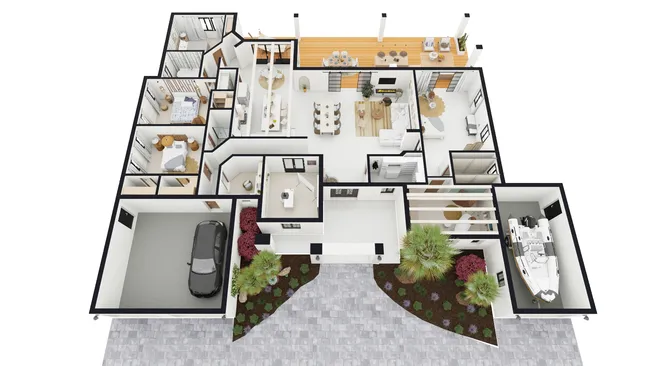
Credibility is another pillar. Strengthen it by including:
- Testimonials
- Awards and certifications
- Press mentions
Layer in strategic SEO (Search Engine Optimization) practices:
- Keyword-rich headings
- Optimized image descriptions
- Optimizing specific pages for important keywords for your business
- Optimise for GEO (Generative Search Optimization: Publish comprehensive, Q&A style content, structure information logically with bullets and summaries, and spread your expertise across platforms like Reddit and Quora.
What are keywords?: Keywords are the words or short phrases people type into search engines when looking for information. For architects, these might include terms like “modern home addition,” “residential architect in [city],” or “sustainable design ideas.” Use them naturally in your website copy, blog posts, and image descriptions. Well-placed keywords help your content appear in relevant searches and attract the right audience without sounding forced.
Finally, make your contact information prominent and friction-free:
- Inquiry form
- Click-to-call button
- Phone number and address
- Social links
- Chat features
Think of your website not just as a brochure but as a business development tool that works for you 24/7.
Optimize Your Google Business Profile
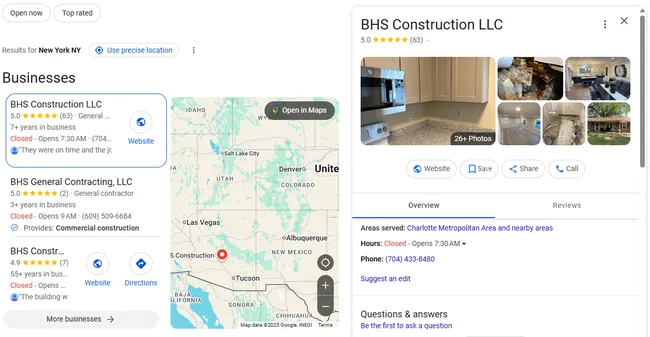
If your website is your digital office, your Google Business Profile (GBP) is your digital storefront. It’s often the first impression local clients get when they search for “architect near me” or “architecture firm in [city].”
Benefits of an optimized profile:
- More website visits
- Increased phone calls and direction requests directly from search
- Higher ROI because it reaches prospects already in decision mode
Steps to optimize your GBP:
- Fill out every field: description, services, hours, contact info
- Add categories that match your specialties (residential, commercial, remodeling, sustainable)
- Upload high-quality project photos
- Write a keyword-rich business description that includes your target market and architectural services
- Post regular updates with project news, certifications, and design tips to show activity
- Use the Q&A section to answer common client questions directly
- Ensure your NAP (Name, Address, Phone) details are consistent across all directories for local SEO
Client reviews are another key driver of trust:
- Encourage satisfied clients to leave detailed reviews
- Respond to every review, positive or negative
Together, your website and Google Business Profile form the foundation of your digital marketing ecosystem to attract potential clients. Get these right, and every other strategy from SEO to social media to email marketing will perform significantly better.
Showcase Your Work with Visual Storytelling
Storytelling is an important part of your marketing plan.
Visual storytelling makes your designs relatable and memorable by pairing images with context to show the problem, the solution, and the transformation. In marketing, this is especially powerful because clients often struggle to picture the end result until you guide them through it.
Build a Standout Architecture Firm’s Portfolio
Your architecture portfolio is often the deciding factor for potential clients. A strong portfolio goes beyond pretty pictures, it tells a story.
Instead of only posting photographs, consider creating case studies that walk your target market through the full process:
- The challenge the client faced
- The solution you designed
- The results that were achieved
This format builds credibility and shows prospects how you think, not just what you create.
More clients also want to see variety. So look for ways to showcase different project types (residential, commercial, remodels) to demonstrate range. Consider organizing your portfolio online so visitors can filter by style, size, or budget range.
Cedreo makes this even easier by allowing you to:
- Generate hypothetical projects for target markets you want to reach
- Create high-quality 2D and 3D images that look like finished photography
- Update and expand your portfolio quickly without waiting for construction photos
Use Photorealistic 3D Renderings

Visuals create emotional connections faster than words. For an architecture firm marketing plan, this is a huge advantage.
Clients respond to renderings because they:
- Show exactly what a project will look like before construction
- Help non-technical audiences understand design intent
- Build excitement and trust early in the process
Use these images in your marketing efforts in multiple ways:
- On your website’s project pages
- In social media posts to showcase new ideas
- Within digital ads that capture attention
With Cedreo, you don’t need weeks of modeling or outsourcing. You can create photorealistic 3D renderings in minutes, complete with lighting, textures, and finishes. These visuals boost lead generation because they stop prospects mid-scroll and invite them to imagine themselves in the space.
The combination of a compelling portfolio and realistic renderings turns your marketing efforts into a persuasive storytelling tool that helps you stand out in a crowded market.
Content Marketing Strategies for Architecture Firms
What is content marketing? Content marketing is the practice of creating and sharing valuable information that attracts and educates potential clients.
Instead of direct selling, a content marketing plan builds trust by answering questions, showcasing expertise, and guiding prospects through their decision-making process.
For architects, it’s an opportunity to demonstrate design knowledge, highlight past successes, and position your firm as the go-to choice when clients are ready to start a project.
Publish Educational Articles & Guides
Publishing valuable content is one of the most effective ways to position you or your firm as an authority. Blog posts, whitepapers, and client guides help you share expertise while also improving your search visibility.
When creating articles, focus on topics that answer common client questions.
Use SEO tools to identify high-demand keywords and trending topics. This ensures your content attracts the right audience while positioning your firm as a trusted resource.
Tips for execution:
- Keep articles clear and free of jargon
- Add images, diagrams, or Cedreo renderings to illustrate points
- Make the article truly helpful instead of just being a sales pitch
- End each piece with a call-to-action that leads to consultation or portfolio viewing
Create Short-Form Video Content
Video marketing is becoming more and more important because it grabs attention quickly and builds trust. Short-form videos are especially powerful for architects who want to showcase process and personality.
Examples of effective marketing video content:
- Time-lapse of a building’s progress
- Behind-the-scenes clips of your design process
- Client testimonials explaining how your work improved their space
- Show the process of doing virtual or in-person consultations
Distribute these videos across platforms where your audience spends time, such as Instagram Reels, Pinterest, and YouTube Shorts.
Keep videos authentic and concise…30 to 60 seconds is ideal. And be sure to use captions since many viewers watch without sound.
Social Media Marketing for Architects
Social media marketing isn’t just for the influencers. It gives architecture firms a way to showcase their work where clients are already looking for inspiration.
Done well, it builds awareness, strengthens credibility, and keeps your architectural business top-of-mind when prospects are ready to choose a partner.
Choose the Right Social Media Platforms

Social media can be overwhelming if you try to be everywhere at once. So focus on the channels that align with your audience and project types:
- LinkedIn: Best for B2B and commercial clients. Share thought leadership, industry trends, and firm updates.
- Instagram & Pinterest: Ideal for residential projects. Visual platforms that highlight design inspiration and finished spaces.
- Houzz: A go-to platform for homeowners researching remodels and design professionals.
By prioritizing the right platforms, you’ll spend less time chasing likes and more time connecting with prospective clients.
Share the Right Content
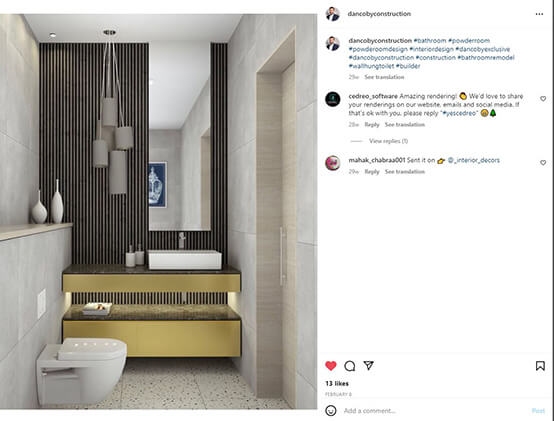
What you post matters as much as where you post it. Strong content reinforces your expertise and builds trust with your target audience.
Ideas for effective posts:
- Project milestones with before-and-after visuals (people love these!)
- Certifications, awards, and press mentions.
- Quick design tips or answers to common client questions.
- Show how you are keeping up with the latest architecture trends (green buildings, smart home integration, design trends, etc)
Balance visuals with thought leadership:
- Renderings from Cedreo that showcase your vision
- Short videos highlighting your design process
- Stories that humanize your firm and show the people behind the projects
Consistency is key. A steady posting schedule keeps you visible and top-of-mind when prospects are ready to choose an architect.
Pro tip: Be careful not to get caught in the content creation trap. It’s easy to spend too much time chasing likes and followers on social media at the expense of your real work. Focus on creating content that drives results, but never lose sight of your primary goal…delivering great designs for your clients.
How to Market an Architecture Firm with Partnerships & Referrals
Traditional marketing methods relied heavily on partnerships and referrals. But even today, they’re not outdated. They’re still one of the most effective ways to generate steady work as an architect. People are far more likely to trust a professional who comes recommended by someone they already know.
Opportunities include:
- Builders and contractors: Collaborate to offer bundled services. A builder who trusts your design skills may bring you into projects early
- Interior designers: Team up on renovations or new builds to deliver a better client experience
- Real estate agents: They can refer potential clients to you (maybe someone who purchased a home and wants to make some updates)
- Suppliers
You can strengthen these relationships with:
- Referral programs that reward partners for sending leads your way.
- Co-marketing campaigns, such as joint open houses, shared blog posts, or cross-promotion on social media.
Paid Advertising Strategies
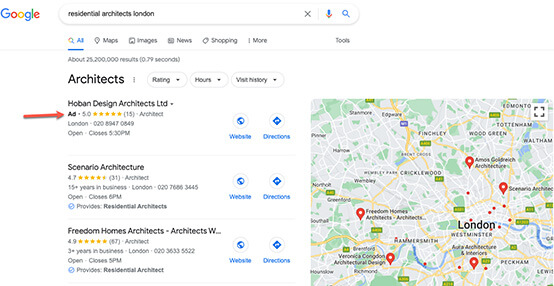
Paid ads can be a smart complement to your organic marketing efforts.
Best options for architects:
- Google Ads: Target local keywords like “residential architect [city]” or “commercial building design [city].” These reach people actively searching for services.
- LinkedIn Ads: Effective for B2B commercial leads. Sponsored posts or InMail campaigns can put your work in front of developers, investors, or corporate decision-makers.
- Facebook/Instagram Ads: Great for residential prospects. Use carousel ads with Cedreo visuals to show off before-and-after designs or 3D renderings.
Tips for success:
- Start with a modest budget and test different ad formats
- Use strong visuals. Renderings or project photos catch the eye faster than text
- Always include a clear call-to-action such as “Book a Consultation” or “View Our Portfolio”
- Be prepared to test, refine, and adjust to improve results
Caution: Be careful with low-ROI lead generation platforms that promise bulk inquiries for a fee. These often result in low-quality leads and wasted time. Instead, focus your budget where you can target specific demographics and track results.
Authority & Trust Building
Building authority and trust is essential in an industry where clients invest heavily and commit long-term. The more credibility architecture firms establish, the easier it is to win projects.
Ways to build authority:
- Public speaking: Present at podcasts or local events to demonstrate thought leadership.
- Design competitions & awards: Recognition from peers and industry bodies enhances credibility and gives you a marketing asset.
- Press & publications: Get featured in local newspapers, business journals, or architecture magazines to expand your visibility beyond your own channels.
- Certifications: Highlight specialized credentials such as sustainable design, LEED, or smart home technology to appeal to modern clients who value innovation.
- Share client success stories in case studies.
Authority is not just about public praise. It’s about consistently showing expertise, transparency, and a commitment to client success.
Create Persuasive Proposals & Presentations
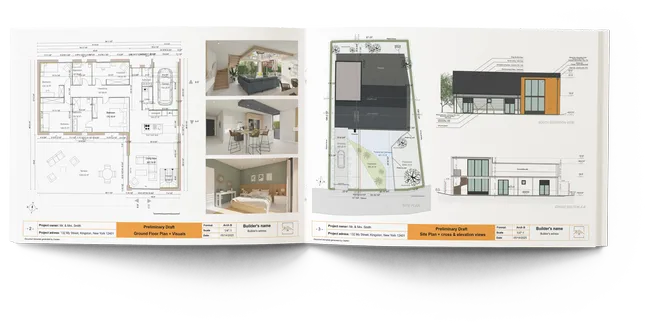
Proposals are often the final hurdle before architecture firms land a project. A generic text-heavy document can weaken your chances, while a polished, visual presentation can set you apart.
Why professional proposals matter:
- They show attention to detail and professionalism
- Visuals help clients understand complex concepts
- A clear layout builds confidence and shortens the decision-making process
Cedreo makes creating persuasive proposals simple. With the ability to combine:
- 2D floor plans that highlight functionality
- 3D renderings that bring spaces to life
- Branded presentation documents that reinforce your firm’s identity
These tools allow you to deliver proposals that are persuasive. Instead of imagining what a project might look like, clients see it. This makes them far more likely to sign with you.
Pulling It All Together – Building Your Architecture Marketing Plan
By now, you’ve seen how each of these marketing strategies works together to create a powerful system for architecture firm marketing.
The key is to approach your efforts in the right order:
- Start with the foundation: Build a professional website and optimize your Google Business Profile.
- Build visibility: Use content marketing and social media to expand your reach.
- Create trust: Showcase your portfolio, gather testimonials, and establish authority through awards and publications.
- Scale smartly: Layer in partnerships, referrals, and paid ads once your basics are solid.
Consistency is what ties it all together. Marketing for architecture firms isn’t a one-time project, it’s an ongoing effort. So track results regularly, refine your approach, and double down on what works best for your firm.
Apply these proven strategies and you’ll attract better-fit clients, shorten sales cycles, and fuel your architecture business growth in a competitive market.
Use Cedreo to Attract Clients with Your Architectural Marketing
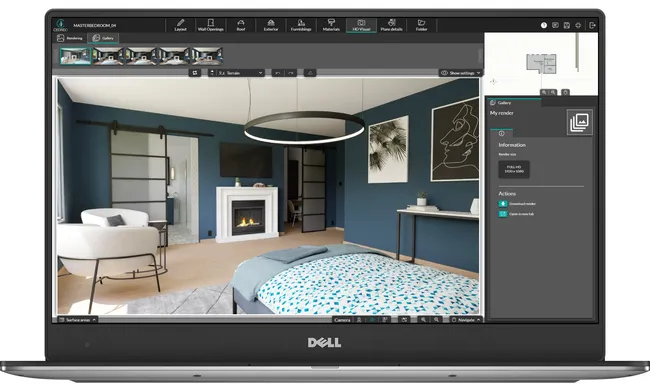
Modern architecture marketing is all about visibility, trust, and presentation. By combining digital strategies with compelling visuals, you can attract better clients and close projects faster.
Cedreo makes this easier by giving you the tools to create 2D floor plans, photorealistic 3D renderings, and professional proposals in minutes.
Ready to stand out in a competitive market? Start creating stunning project presentations today with Cedreo’s intuitive 3D design software.
Architecture Marketing FAQs
Many architecture firms use a mix of marketing strategies to generate leads. Referrals, traditional architecture firm marketing (referrals, partnerships), email marketing, and social media platforms help attract clients. A strong online presence and search engine optimization also bring in more clients through search engine results pages.
Marketing for architects requires showing the value of architectural services. Use content marketing, email marketing, paid ads, partnerships, referrals, and social media marketing to reach your target audience. A solid marketing strategy highlights your firm’s services, builds trust, and attracts ideal clients.
Marketing for architects works best with a robust digital marketing strategy. Share your architecture firm’s portfolio online, optimize website content, and use an optimized Google Business Profile to attract potential clients. You can even reach your target audience through social media. Pinterest and Instagram work great for interior designers and architects.
Yes, digital marketing helps architecture firms attract new clients. Online marketing gets you more website visitors, generates leads, and strengthens existing client relationships. A strategic marketing plan for your online presence is the right marketing strategy for long-term business growth.
An effective architecture marketing plan blends traditional and digital marketing. Use search engine optimization, social media, and effective marketing online to attract potential clients. Combine that with partnerships and referrals. Strategic marketing strategies like those help architecture firms get more business opportunities.



